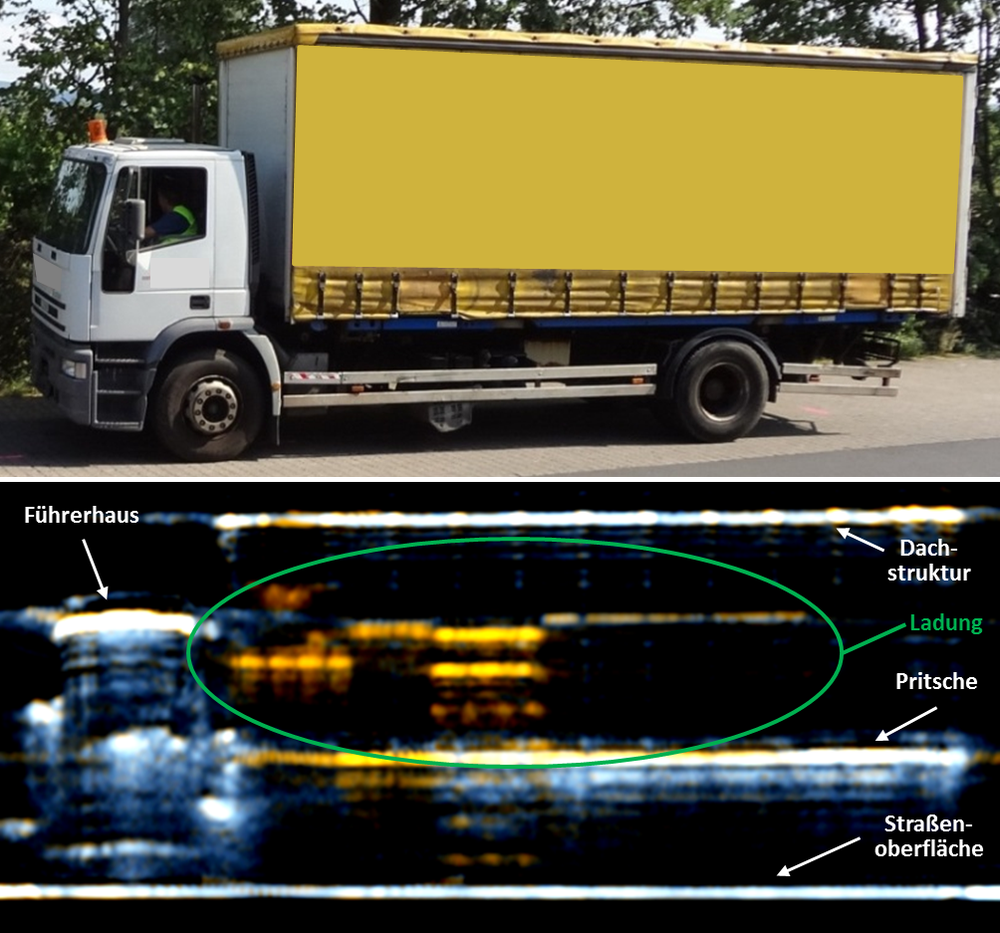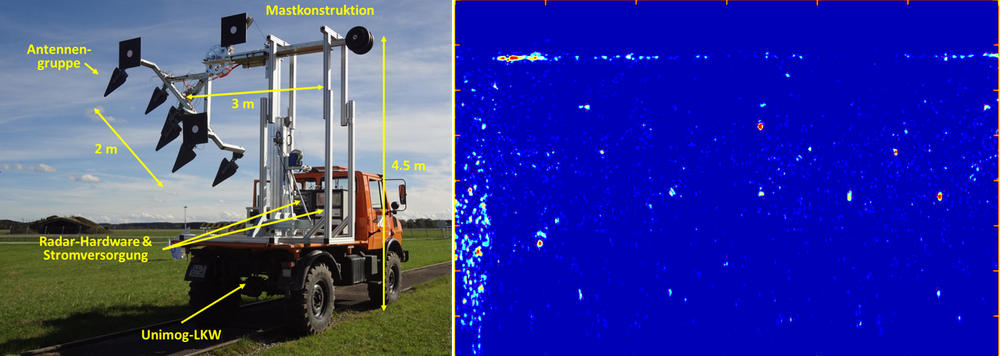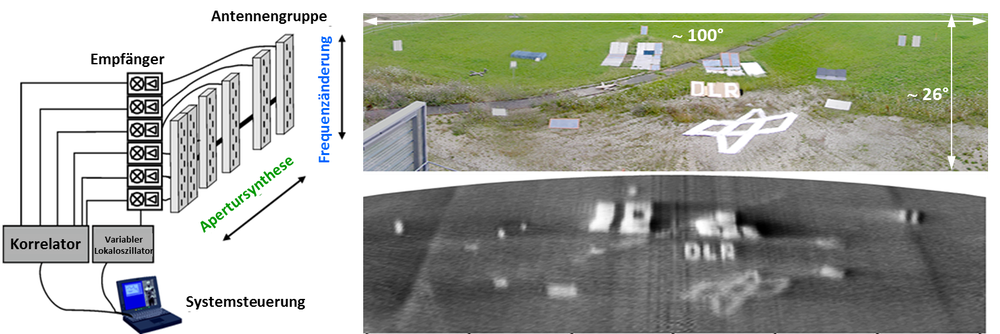Microwaves Sensors
Within the framework of military and civilian oriented research the group develops and constructs active and passive microwave sensors for microwave remote sensing. Collaterally a detailed system simulation is mandatory, supporting the work in addition to the required instrumentation. Furthermore the relevant computations of microwave signatures are performed in order to investigate, predict, and compare those, and in order to be able to modify the behavior and performance of the sensor systems. The development and construction work is mostly performed on a system engineering level, i.e. commercially available subsystems or single components are externally purchased, if a reasonable value for money is given. Non-available components are developed and constructed in house. Beside microwave techniques, required activity in the analogue and digital low-frequency range is exercised. Signal conditioning and data acquisition plays an important role in remote sensing. Here the subsystems are as well externally purchased and combined via adequate control software following the specific requirements of an application, e.g. real-time capability. The global objective for the sensor development is the realization of highest performance at low costs. Consequently novel imaging principles are of major interest.
Active sensors
Ground-based imaging radar
Modern radar applications for reconnaissance and security make use of highly resolved descriptions of the radar cross section (RCS) distribution necessary for advanced target recognition. Polarimetric features can act as an additional information source, allowing primarily the identification of scattering mechanisms. The use of different wavebands, e.g. from P to Ku-band, enable different scattering and penetration phenomena to be revealed for complicated objects. Multiple channels in transmit and receive furthermore can help to improve the discrimination of objects from background clutter considerably. To investigate the potential of these capabilities experimentally, and for collecting true radar signatures, a powerful radar system operating in L/S, C, X, and Ku-band called UNIRAD has been developed and used in the past. A more recent developed and constructed radar system called GIGARAD has a high degree of digital components in transmit signal generation and receive signal acquisition even for high pulse repetition rates. Gigarad can operate from 8 to 14 GHz in a single pulse offering a theoretical range resolution of up to 2.5 cm. Two independent transmit and two independent receive channels acquiring the full bandwidth in time domain allow a high flexibility in signal processing for multiple challenging applications. For high penetration capabilities through various dielectric materials like soils typically lower microwaves are suitable. For buried landmine and UXO (UneXploded Ordnance) detection the radar system TIRAMI-SAR has been developed and constructed within the EU FP-7 project TIRAMISU (http://fp7-tiramisu.eu/). TIRAMI-SAR has roughly a similar architecture as Gigarad and operates in the UHF band from 500 MHz to 3 GHz. All radar systems can be operated following the SAR (Synthetic Aperture Radar – the scene is fixed and the radar is moving) or ISAR (Inverse SAR – the radar is fixed and the scene is moving) principle. This technique allows the generation of range independent radar backscatter images at very high spatial resolution based on coherent signal processing of consecutive radar range profiles.
Imaging at very high spatial resolution
Figure 1 shows the RCS distribution of a lying bicycle at very high spatial resolution. Hence very much detail like the wheels, the structure of the frame, and the drive system can be recognized. Note that very much parts of the bicycle are in the size order of the wavelength (˜3 cm) or even much smaller.
Imaging of non-typical radar targets
Figure 2 shows high-resolution radar images of persons in various poses and differently applied imaging principles. The left images correspond to a conventional two-dimensional ISAR imaging technique. In that situation the person cannot be distinguished by the radar echo (scattering centers), which even appears on the wrong position, but quite clearly by the radar shadow. For the right images a three-dimensional ISAR approach has been applied for data acquisition resulting in a true three-dimensional representation of the scattering centers. The radar image illustrates two persons as they could be observed optically in a side view. One person is sitting on a chair, and the other one standing person is carrying a rifle mockup in her hands. Now the radar echoes are located on correct positions.
Through-wall imaging
Microwave radar is quite useful for performing inspection of a volume behind a dielectric wall due its high penetration capabilities. Figure 3 shows the result of a project performed in cooperation with an industrial partner where the goal was the estimation of truck load under canvas. The image was generated by using the trucks own motion in driving direction and applying the ISAR principle. In cross-track direction an array of transmit and receive antennas has been used for true three-dimensional imaging. The structure of the individual load can be clearly identified, beside the general structure and detail of the truck itself.
Landmine and UXO detection
Microwave radar at lower frequencies can detect buried objects in soil. Hence the application of imaging radar for landmine and UXO detection is a powerful tool for investigating larger contaminated areas in reasonable time. Figure 4 shows a result of several mine/UXO like targets buried in sand and imaged by the TIRAMI-SAR system operated on a truck. TIRAMI-SAR is using multiple transmit and receive antennas for applying spatial diversity or multi-static wave propagation in order to suppress background clutter. Hence buried objects can be clearly detected.



Passive sensors
Microwave radiometry
Radiometry addresses the domain of the passive measurement of the natural, thermal electromagnetic radiation of matter at a physical temperature above 0 K. In the case of microwave or millimeter-wave Earth observation, significant contrasts can be observed between reflective and absorbing materials, due to the impact of reflected sky radiation of cosmic origin. The incident radiation power measured by a radiometer system is usually expressed in an apparent temperature, the brightness temperature. For Earth observation, an approximate range from 3 K to more than 300 K can be observed. The spatial two-dimensional brightness temperature distribution can be used as a daytime and almost weather independent indicator for many different physical phenomena. Based on a large experience in using radiometric imaging, our focus now is more on various security applications.
Security applications
The continuous threats by international terrorism increase the danger to the public and create a new and more complex threat dimension. This evolution can only be combated by the application of new counter-measure methods like advanced imaging technologies for surveillance and the detection of concealed dangerous objects. For the observation of a variety of security critical premises, borders, and maritime coastal areas, there is a strong demand on wide field-of-view imaging for intruder detection under all adverse ambient conditions. The imaging of persons with respect to weapons and explosives detection is of increasing interest, particularly for airlines, transportation services, or public events with large crowds.
The penetration capability of microwaves allows the detection of objects through atmospheric obstacles, like bad weather, fog, dust, vapor and smoke, as well as through thin non-metallic materials and clothing. For the latter, the detection of hidden objects like weapons, explosives, and contraband is possible by monitoring dielectric anomalies. Furthermore, the acquisition of polarimetric object characteristics can increase the detection capability by gathering complementary object information. Based on the physical principles of microwave radiometry, images have a quasi-optical appearance, simplifying the image interpretation for the operator. In addition, the sensor operation is inherently passive and covert.
During the years various experimental imaging radiometer systems have been developed. A favorite imaging principle is a fully-mechanical line-scanner due to its rather simple and cheap construction. For the imaging of large scenes like a full hemisphere at several wavebands the ABOSCA imager has been developed and constructed. Two-dimensional imaging is done by rotating an offset parabola antenna for generating an elevation line scan, and by rotating that whole unit in azimuth for the second image dimension. ABOSCA is operated at D, W, Ka, and X band resulting in angular resolutions from about 0.4° to 6.5°. For fast image acquisitions of large scenes in up to one image per second the SUMIRAD system was developed and constructed. SUMIRAD performs two-dimensional imaging by a fully-mechanical up and down raster scanning using a rotating deviation plate between two fixed Cassegrain type focusing antennas and two receivers for two linear polarizations. SUMIRAD is operated at W band providing an angular resolution of about 0.75° and an image size of >80° in azimuth and 30° in elevation. For fast imaging and low maintenance expense fully-electronic scanning is beneficial. Investigations on approaches requiring lowest number of antenna and receiver elements resulted in the development of the VESAS principle. Here elevation scanning is done by frequency shift and azimuth scanning by aperture synthesis. An experimental system for proof of concept has been developed and constructed at Ka band giving an angular resolution around 0.9°.
Detecting intruders by change detection approaches
For proper detection of intruders in sensitive areas like critical infrastructures the operation of surveillance systems at day and night time and in adverse weather or sight conditions like rain, fog, smoke or dust is mandatory. Hence a passive millimeter-wave radiometer is an appropriate instrument providing sufficient spatial resolution, atmospheric penetration, and covert no-emission operation in parallel. Figure 5 shows the result of an experiment for the purpose of imaging an approaching person and applying change detection using consecutive images in comparison. In the optical and the radiometer image the person is hard to discriminate from the scenes background clutter, given by buildings and other infrastructure. However, the presence of the person can be clearly detected in the change detection image, although about 20 minutes have passed between the radiometer image with person and the reference image without person. Only minor other changes appear due to a variation of sun glint on reflecting metallic surfaces since the sun has shifted its position on sky by about 5° over that time.
Imaging at high frame rates
For many applications, especially in the domain of security and safety, a high frame rate for imaging is required in parallel to large fields of view, high spatial resolution and sufficient sensitivity. This circumstance provides a big challenge for radiometric imaging systems using today’s technology and bearing in mind affordable costs. For instance, the detection of suspicious objects along a road is of big interest for patrol vehicles during driving. Figure 6 shows a road scene where two metallic barrels located on the road side are approached by a vehicle carrying a video camera and a fast imaging millimeter-wave radiometer. The barrels are covered by white blankets. Independent of what material type is below the blankets the video camera only can show the surface of the blankets, but the spatial resolution is quite high due to the short wavelength and so detection at long distance is possible. In contrast, the radiometer image shows the high reflectivity of the barrels, being an indicator for metal objects below the blankets which could pose a threat. Of course the radiometers spatial resolution is worse allowing detection only at shorter ranges. However, these relationships suggest the use of one another complementing sensor systems and data fusion for added value in information gathering.
Proof of concept for fully-electronic imaging
The VESAS principle combines two electronic scanning methods for two-dimensional imaging as illustrated in figure 7 left. Vertical scanning is done by frequency shift and horizontal scanning is performed by aperture synthesis. For frequency scanning a type of traveling wave antenna (e.g. slotted waveguide antenna) is used where the single radiating elements (e.g. slots) have equal geometrical distance. By changing the operational frequency the phases between the radiators are changed by the identical amount resulting in a corresponding variation of the main beam direction. Aperture synthesis is an imaging technique originally developed and used for radio astronomy. Here a large antenna is synthesized by a sparse array of small antennas. The signals from each antenna pair (baseline) are complex cross-correlated, i.e. amplitude and phase or real and imaginary part are measured. Sampling all baselines within the array according to the sampling theorem, the brightness temperature distribution can be reconstructed for an ideal system by a Fourier inversion. Figure 7 right illustrates an example applying successfully the VESAS principle where various metallic and non-metallic targets of different size and shape have been located on a meadow. The scene was imaged from the roof of a building using a two-element demonstrator measuring all baselines in time multiplex.



